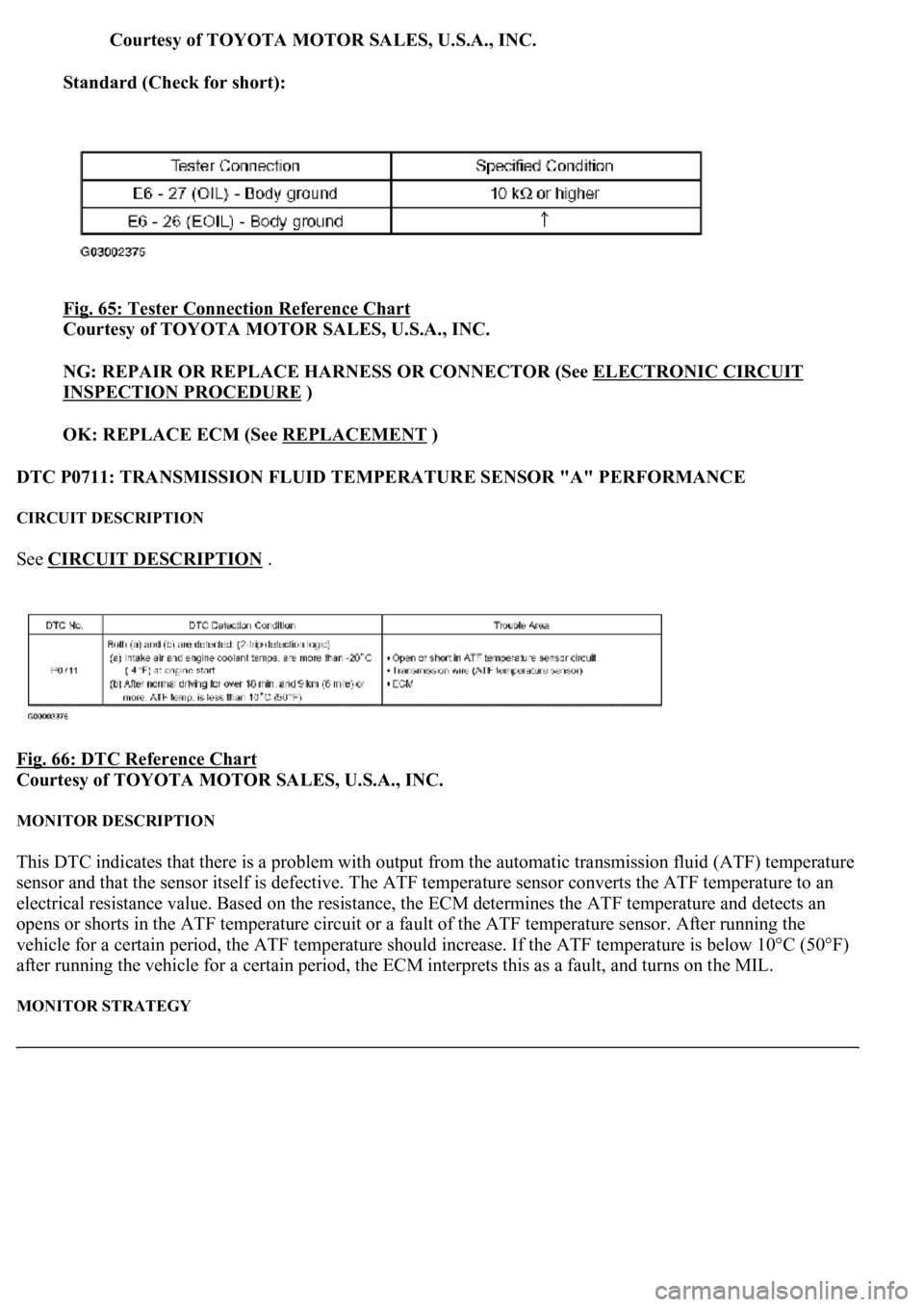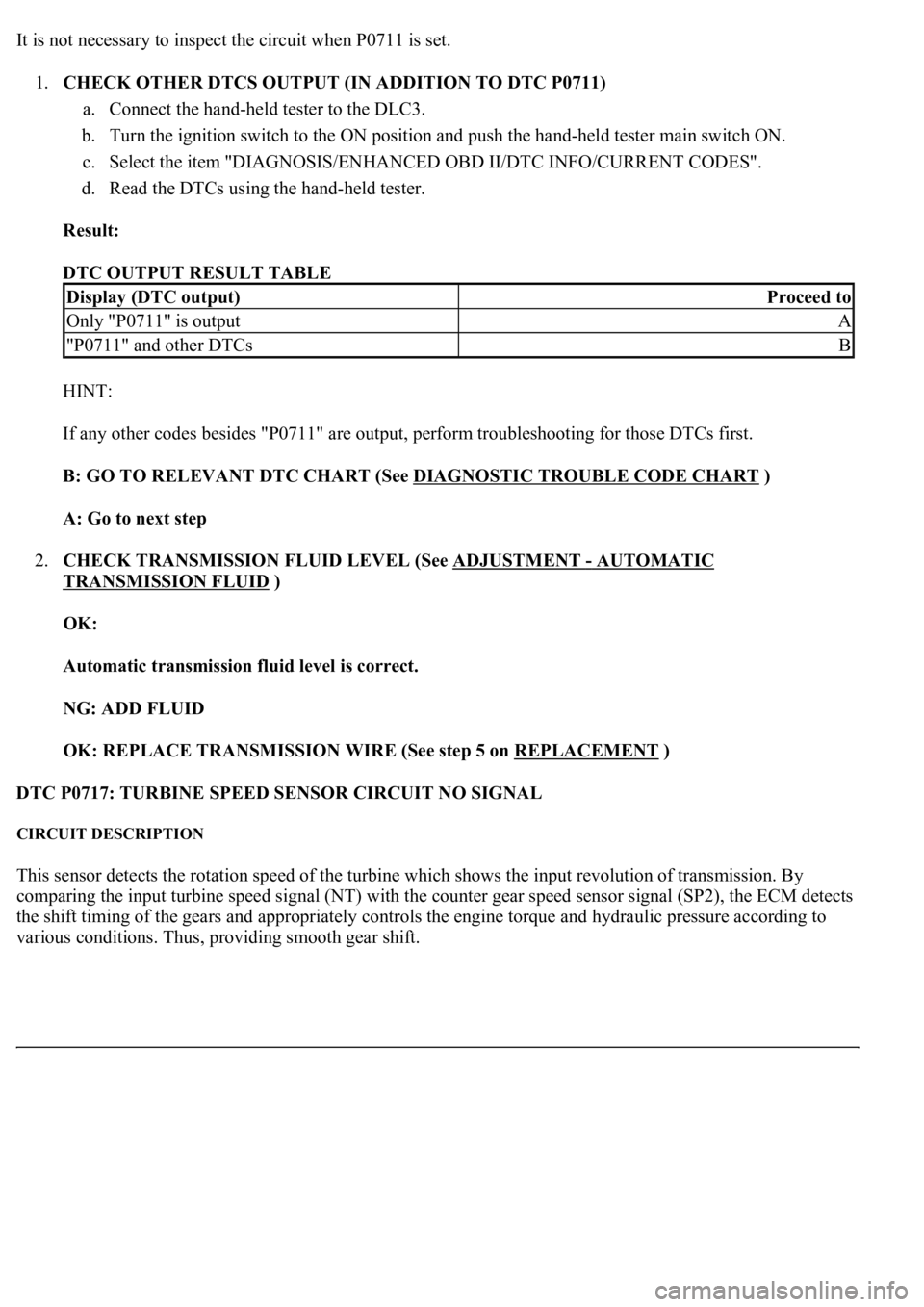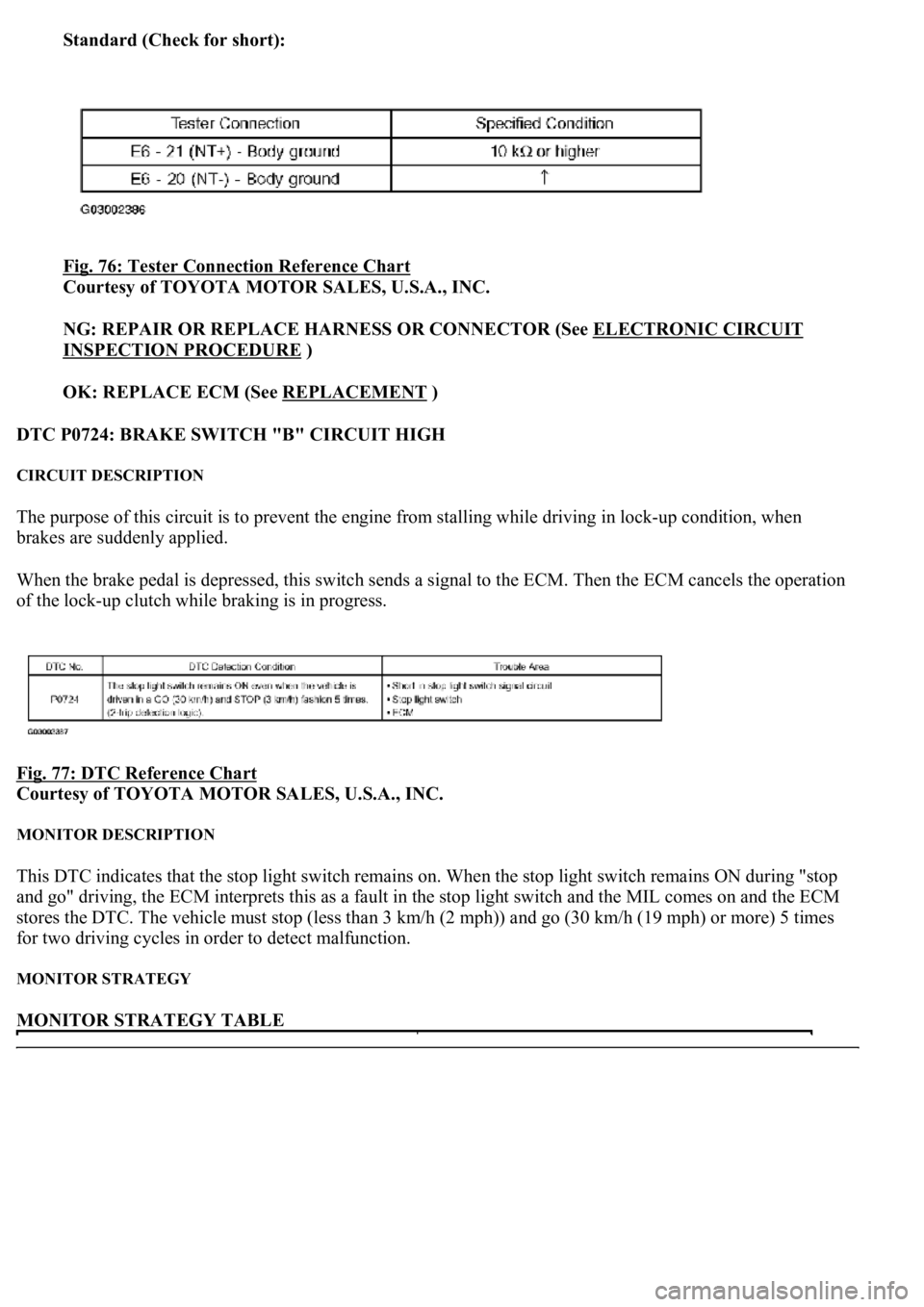Page 2747 of 4500
Fig. 63: Transmission Wire Connector Reference Chart
Courtesy of TOYOTA MOTOR SALES, U.S.A., INC.
NG: REPAIR OR REPLACE TRANSMISSION WIRE (See step 5 on REPLACEMENT
)
OK: Go to next step
2.CHECK HARNESS AND CONNECTOR (TRANSMISSION WIRE - ECM)
a. Connect the transmission wire connector to the transmission.
b. Disconnect the ECM connector.
c. Measure the resistance according to the value(s) in the table below.
Standard:
TRANSMISSION WIRE - ECM - RESISTANCE TABLE
d. Measure the resistance according to the value(s) in the table below.
Fig. 64: Disconnecting ECM Connector
Tester ConnectionSpecified Condition
E6 - 27 (OIL) - E6 - 26 (EOIL)79ohms to 156kohms
Page 2748 of 4500

Courtesy of TOYOTA MOTOR SALES, U.S.A., INC.
Standard (Check for short):
Fig. 65: Tester Connection Reference Chart
Courtesy of TOYOTA MOTOR SALES, U.S.A., INC.
NG: REPAIR OR REPLACE HARNESS OR CONNECTOR (See ELECTRONIC CIRCUIT
INSPECTION PROCEDURE )
OK: REPLACE ECM (See REPLACEMENT
)
DTC P0711: TRANSMISSION FLUID TEMPERATURE SENSOR "A" PERFORMANCE
CIRCUIT DESCRIPTION
See CIRCUIT DESCRIPTION .
Fig. 66: DTC Reference Chart
Courtesy of TOYOTA MOTOR SALES, U.S.A., INC.
MONITOR DESCRIPTION
This DTC indicates that there is a problem with output from the automatic transmission fluid (ATF) temperature
sensor and that the sensor itself is defective. The ATF temperature sensor converts the ATF temperature to an
electrical resistance value. Based on the resistance, the ECM determines the ATF temperature and detects an
opens or shorts in the ATF temperature circuit or a fault of the ATF temperature sensor. After running the
vehicle for a certain period, the ATF temperature should increase. If the ATF temperature is below 10°C (50°F)
after running the vehicle for a certain period, the ECM interprets this as a fault, and turns on the MIL.
MONITOR STRATEGY
Page 2751 of 4500

It is not necessary to inspect the circuit when P0711 is set.
1.CHECK OTHER DTCS OUTPUT (IN ADDITION TO DTC P0711)
a. Connect the hand-held tester to the DLC3.
b. Turn the ignition switch to the ON position and push the hand-held tester main switch ON.
c. Select the item "DIAGNOSIS/ENHANCED OBD II/DTC INFO/CURRENT CODES".
d. Read the DTCs using the hand-held tester.
Result:
DTC OUTPUT RESULT TABLE
HINT:
If any other codes besides "P0711" are output, perform troubleshooting for those DTCs first.
B: GO TO RELEVANT DTC CHART (See DIAGNOSTIC TROUBLE CODE CHART
)
A: Go to next step
2.CHECK TRANSMISSION FLUID LEVEL (See ADJUSTMENT
- AUTOMATIC
TRANSMISSION FLUID )
OK:
Automatic transmission fluid level is correct.
NG: ADD FLUID
OK: REPLACE TRANSMISSION WIRE (See step 5 on REPLACEMENT
)
DTC P0717: TURBINE SPEED SENSOR CIRCUIT NO SIGNAL
CIRCUIT DESCRIPTION
This sensor detects the rotation speed of the turbine which shows the input revolution of transmission. By
comparing the input turbine speed signal (NT) with the counter gear speed sensor signal (SP2), the ECM detects
the shift timing of the gears and appropriately controls the engine torque and hydraulic pressure according to
various conditions. Thus, providin
g smooth gear shift.
Display (DTC output)Proceed to
Only "P0711" is outputA
"P0711" and other DTCsB
Page 2752 of 4500
Fig. 68: Identifying Turbine Speed Sensor Components
Courtesy of TOYOTA MOTOR SALES, U.S.A., INC.
Fig. 69: DTC Reference Chart
Courtesy of TOYOTA MOTOR SALES, U.S.A., INC.
Reference (Using an oscilloscope):
Check the waveform between the terminals NT+ and NT- of the ECM connector.
Standard: Refer to the illustration.
Page 2753 of 4500
Fig. 70: Identifying Waveform
Courtesy of TOYOTA MOTOR SALES, U.S.A., INC.
WAVEFORM REFERENCE TABLE
MONITOR DESCRIPTION
This DTC indicates that pulse is not output from the speed sensor NT (Turbine (input) speed sensor) or is output
only little. The NT terminal of the ECM detects the revolving signal from speed sensor (NT) (input RPM). The
ECM outputs a gearshift signal comparing the input speed sensor (NT) with the output speed sensor (SP2).
While the vehicle is operating in the 4th, 5th or 6th gear position in the shift position of D, if the input shaft
revolution is less than 300 rpm*1 although the output shaft revolution is more than 300 rpm or more*2, the
ECM detects the trouble, illuminates the MIL and stores the DTC.
*1: Pulse is not output or is irregularly output
*2: The vehicle speed is approx. 50 km/h (31 mph) or more.
TerminalNT+ - NT-
Tool setting1V/DIV, 2ms/DIV
Vehicle conditionEngine idle speed (P or N position)
Page 2754 of 4500
MONITOR STRATEGY
MONITOR STRATEGY TABLE
TYPICAL ENABLING CONDITIONS
TYPICAL ENABLING CONDITIONS TABLE
TYPICAL MALFUNCTION THRESHOLDS
TYPICAL MALFUNCTION THRESHOLDS TABLE
COMPONENT OPERATING RANGE
COMPONENT OPERATING RANGE TABLE
WIRING DIAGRAM
Related DTCsP0717: Speed sensor (NT)/Verify pulse input
Required sensors/ComponentsSpeed sensor (NT)
Frequency of operationContinuous
Duration5 sec.
MIL operationImmediate
Sequence of operationNone
The monitor will run whenever this DTC is not
present.See LIST OF DISABLE A MONITOR
Shift changeShift change is completed and before starting next
shift change operation
ECM selected gear4th, 5th or 6th
Output shaft rpm1,000 rpm or more
NSW switchOFF
R switchOFF
EngineRunning
Sensor signal rpmLess than 300 rpm
Speed sensor (NT)Input speed is equal to engine speed when lock-up
ON.
Page 2758 of 4500
NG: REPLACE SPEED SENSOR (NT)
OK: Go to next step
3.CHECK HARNESS AND CONNECTOR (SPEED SENSOR - ECM)
a. Connect the speed sensor connector.
b. Disconnect the ECM connector.
c. Measure the resistance according to the value(s) in the table below.
Standard:
SPEED SENSOR - ECM - RESISTANCE TABLE
d. Measure the resistance according to the value(s) in the table below.
Fig. 75: Disconnecting ECM Connector
Courtesy of TOYOTA MOTOR SALES, U.S.A., INC.
1 - 2560 to 680 ohms
Tester ConnectionSpecified Condition 20°C (68°F)
E6 - 21 (NT+) - E6 - 20 (NT-)560 to 680 ohms
Page 2759 of 4500

Standard (Check for short):
Fig. 76: Tester Connection Reference Chart
Courtesy of TOYOTA MOTOR SALES, U.S.A., INC.
NG: REPAIR OR REPLACE HARNESS OR CONNECTOR (See ELECTRONIC CIRCUIT
INSPECTION PROCEDURE )
OK: REPLACE ECM (See REPLACEMENT
)
DTC P0724: BRAKE SWITCH "B" CIRCUIT HIGH
CIRCUIT DESCRIPTION
The purpose of this circuit is to prevent the engine from stalling while driving in lock-up condition, when
brakes are suddenly applied.
When the brake pedal is depressed, this switch sends a signal to the ECM. Then the ECM cancels the operation
of the lock-up clutch while braking is in progress.
Fig. 77: DTC Reference Chart
Courtesy of TOYOTA MOTOR SALES, U.S.A., INC.
MONITOR DESCRIPTION
This DTC indicates that the stop light switch remains on. When the stop light switch remains ON during "stop
and go" driving, the ECM interprets this as a fault in the stop light switch and the MIL comes on and the ECM
stores the DTC. The vehicle must stop (less than 3 km/h (2 mph)) and go (30 km/h (19 mph) or more) 5 times
for two driving cycles in order to detect malfunction.
MONITOR STRATEGY
MONITOR STRATEGY TABLE